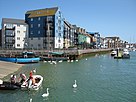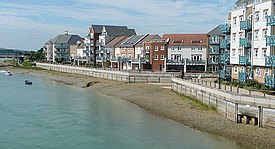Conurbation in England
| Brighton and Hove Built-up Area | |
|---|---|
| Conurbation | |
     Clockwise from top: Brighton Regency Square, Worthing Seafront, Littlehampton Harbour, the River Adur at Shoreham and the Falmer Stadium Clockwise from top: Brighton Regency Square, Worthing Seafront, Littlehampton Harbour, the River Adur at Shoreham and the Falmer Stadium | |
 Map of the Brighton and Hove Built-up Area with labelled subdivisions Map of the Brighton and Hove Built-up Area with labelled subdivisions | |
| Sovereign state | |
| Constituent country | |
| Historic county | |
| Ceremonial county | East Sussex West Sussex |
| Largest settlements | (Pop. 100,000+) |
| Population | |
| • Total | 474,485 |
| • Rank | 12th |
| • Density | 5,304/km (13,740/sq mi) |
| Time zone | UTC+0 (GMT) |
| • Summer (DST) | UTC+1 (BST) |
| Postcode | BN |
| Area code(s) | 01273, 01903 |
The Brighton and Hove Built-up area or Brighton/Worthing/Littlehampton conurbation has a population of 474,485 (2011 census), making it England's 12th largest conurbation. This was an increase of around 3% from the 2001 population of 461,181. Named the Brighton/Worthing/Littlehampton conurbation by the Office for National Statistics for the 2001 census and Brighton and Hove Built-up area for the 2011 census, the area has also been known as Greater Brighton, although the Greater Brighton City Region that was created in 2014 from seven local authorities in Sussex covers a much larger area. The conurbation dominates West and East Sussex, with around one in three of Sussex's population living within its boundaries. It is also the second largest conurbation in the South East region of England and the second largest conurbation on the English Channel coast, in either England or France. In both of these cases the Brighton conurbation trails the Southampton and Portsmouth conurbation. The Brighton/Worthing/Littlehampton conurbation was the largest on the Channel before Portsmouth and Southampton's conurbations were combined for much official data analysis after the 2011 census.
This conurbation is also the UK's most densely populated major conurbation outside London with 5,304 inhabitants per square kilometre (13,740/sq mi). This is due to its tight boundaries between the South Downs national park to the north, and the English Channel to the south together with less land devoted to domestic gardens in English seaside towns than in inland towns.
It is a multi-centred conurbation and the eastern part, the city of Brighton and Hove, has approximately half of its population.
Places in the conurbation
The total distance in a straight line from the western edge of Littlehampton to the eastern edge of Saltdean is between 23 and 24 miles (37 and 39 km). Along the shore or by road, it is slightly further.
The conurbation's population is made up of the following settlements as defined by the Office for National Statistics:
| Urban subdivision | Population (2001 census) | Population (2011 census) |
|---|---|---|
| Brighton | 134,293 | 229,700 |
| Hove | 72,335 | |
| Worthing | 96,964 | 109,120 |
| Littlehampton | 55,716 | 55,706 |
| Shoreham | 17,537 | 48,487 |
| Sompting/Lancing | 30,360 | |
| Portslade | 19,564 | 19,921 |
| Southwick | 11,281 | 11,551 |
| Findon | 1,720 | |
| Rottingdean/Saltdean | 21,411 |
Notes:
- Hove and Brighton were separate subdivisions for the 2001 census but are combined in one Brighton and Hove subdivision for the 2011 census.
- In the 2011 census the Shoreham subdivision includes Sompting and Lancing.
- Findon was not included as part of the Brighton and Hove built-up area for the 2011 census.
- Saltdean and Rottingdean were not included as part of the Brighton and Hove built-up area for the 2011 census and instead form a built-up area called Saltdean/Woodingdean with a population of 22,729.
- In the 2001 census the Littlehampton subdivision included Angmering and Ferring. In the 2011 census the Littlehampton subdivision still includes Angmering but Ferring is part of the Worthing subdivision.
There are some small gaps that help maintain distinct identities of places in the conurbation, although in places the settlements coalesce:
- Goring Gap between Ferring and Goring/Worthing
- Sompting Gap between Worthing and Sompting
- Brooklands Park between Worthing and Lancing
- Lancing Gap between Lancing and Shoreham
Nearby places
Settlements very close to the conurbation but not included in the official statistics include the towns of Peacehaven and Telscombe (separated from Brighton by Telscombe Tye, a small open space, population 23,000), Newhaven (joined to Peacehaven, population 11,000) and Seaford (separated from Newhaven by the River Ouse, population 22,000).
Climate
The coastal towns of Sussex with neighbouring Hampshire and south Kent including the settlements that make up the Brighton and Hove built-up area are the sunniest places in the United Kingdom. The coast has consistently more sunshine than the inland areas: sea breezes, blowing off the sea, tend to clear any cloud from the coast. The sunshine average is approximately 1,900 hours a year; this is much higher than the UK average of 1,340 hours a year.
| Climate data for Brighton | |||||||||||||
|---|---|---|---|---|---|---|---|---|---|---|---|---|---|
| Month | Jan | Feb | Mar | Apr | May | Jun | Jul | Aug | Sep | Oct | Nov | Dec | Year |
| Mean daily maximum °C (°F) | 8 (46) |
8 (46) |
9 (49) |
12 (53) |
16 (60) |
19 (66) |
22 (71) |
22 (72) |
18 (65) |
15 (59) |
11 (52) |
9 (48) |
14 (57) |
| Mean daily minimum °C (°F) | 3 (38) |
3 (38) |
4 (40) |
6 (43) |
9 (48) |
12 (53) |
14 (58) |
14 (58) |
12 (54) |
9 (49) |
6 (43) |
4 (40) |
8 (47) |
| Average precipitation mm (inches) | 88 (3.5) |
60 (2.4) |
51 (2.0) |
58 (2.3) |
56 (2.2) |
50 (2.0) |
54 (2.1) |
62 (2.4) |
67 (2.6) |
105 (4.1) |
103 (4.1) |
97 (3.8) |
851 (33.5) |
| Source: Met Office | |||||||||||||
| Jan | Feb | Mar | Apr | May | Jun | Jul | Aug | Sep | Oct | Nov | Dec | Year |
|---|---|---|---|---|---|---|---|---|---|---|---|---|
| 9.2 °C (48.6 °F) | 8.7 °C (47.7 °F) | 8.2 °C (46.8 °F) | 9.6 °C (49.3 °F) | 11.4 °C (52.5 °F) | 13.6 °C (56.5 °F) | 15.4 °C (59.7 °F) | 16.9 °C (62.4 °F) | 17.3 °C (63.1 °F) | 16.3 °C (61.3 °F) | 14.7 °C (58.5 °F) | 12.0 °C (53.6 °F) | 12.8 °C (55.0 °F) |
See also
References
- ^ "2011 Census - Built-up areas". ONS. Retrieved 3 July 2013.
- "UK Government paper on Greater Brighton". Retrieved 26 May 2015.
- "Southern England: climate". Met Office. Archived from the original on 14 March 2012. Retrieved 14 April 2012.
- "Weather and Climate in Sussex". Visit Sussex. Archived from the original on 30 April 2012. Retrieved 14 April 2012.
- Brighton average sea temperature Archived 6 July 2015 at the Wayback Machine – seatemperature.org
50°49′26″N 0°20′06″W / 50.824°N 0.335°W / 50.824; -0.335
Categories: